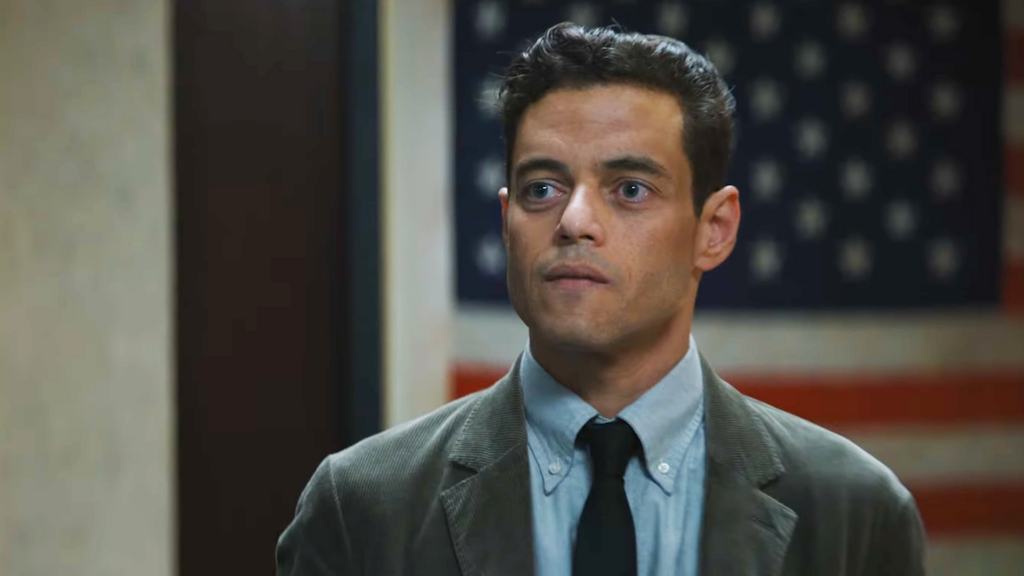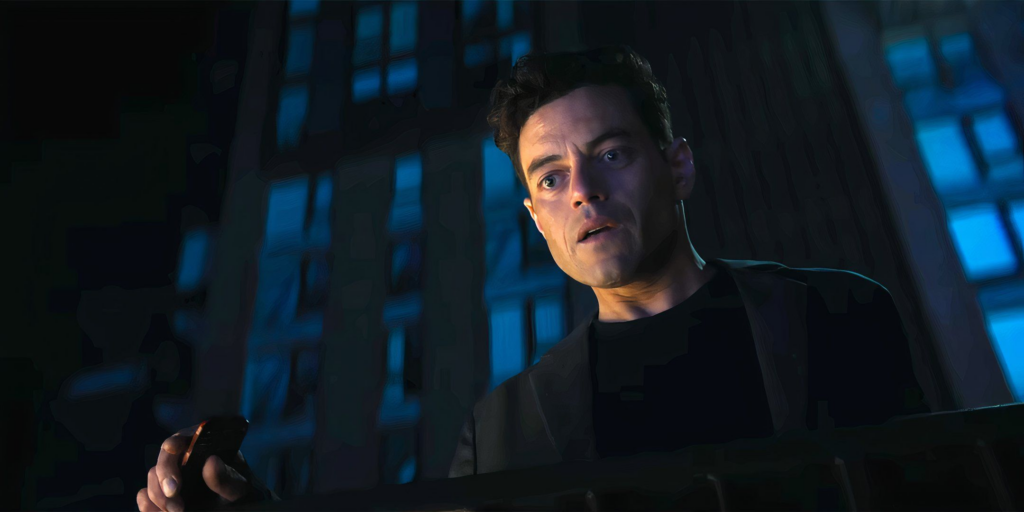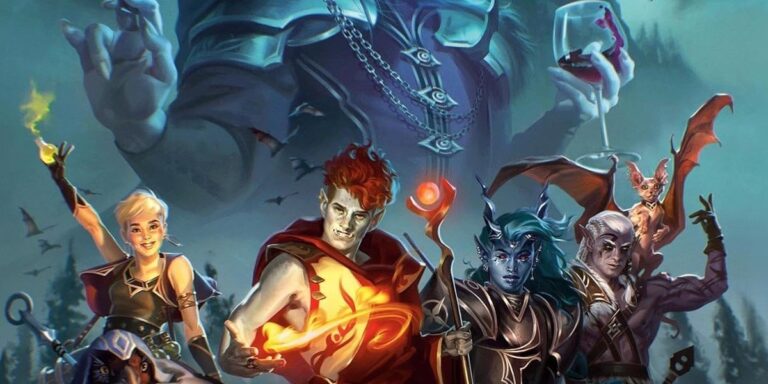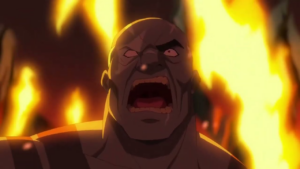“The Amateur” brings action, vengeance, and a deep character study to the big screen. Rami Malek leads with a nuanced performance as Charlie Heller, a CIA cryptographer. When his wife, Sarah, is killed while on a work trip in London his life spirals. After he discovers who her killers are and that the CIA isn’t going to do anything he hatches a plan for vengeance.
Malek shows the internal struggle as he slowly loses himself doing whatever it takes to avenge his wife. Laurence Fishburne, Rachel Brosnahan, and Jon Bernthal deliver dynamic performances that bring their characters to life through their relationships with Malek’s Charlie Heller. The film not only centers around a revenge story, but a complicated espionage thriller with a tactical game of chess being played on the world stage.
“The Amateur” is based on Robert Littell’s novel of the same name with a screenplay penned by Ken Nolan and Gary Spinelli. James Hawes helmed the film as director. Nolan is perhaps best known for adapting the iconic “Black Hawk Down.” Temple of Geek had the opportunity to speak with Nolan about his work on “The Amateur” including his adaptation style and crafting original kill scenes.
Exploring Charlie’s Internal Struggle In The Amateur

Temple of Geek: “The Amateur” is such an intense character study wrapped in the world of espionage and covert opperations which is such a cool duality to explore.
Ken Nolan:
Thank you very much. That was the goal and I think we achieved it. Yeah, I was really surprised. I saw it for the first time at the premier and people were gasping near me and the girl in front of me shielded her eyes at one point. I went, oh my God, this is working. This works. Because you always have doubts like what if the movie doesn’t work? What if it’s a mess? And I think it’s a really solid, excellent movie.
Temple of Geek: How did your work on “Black Hawk Down” and “The Company” help inform your writing process of the covert ops aspect of “The Amateur?”
Ken Nolan:
Well, both of those projects had Ridley Scott attached. So I learned so much from Ridley. I learned so much on the set of “Black Hawk Down” in those four and a half months, more than the 10 years of screenwriting before. He taught me to write with subtlety and to talk, not toward the exact thing they’re trying to say, but talk about something kind of next to it. It’s a very hard thing to put into words.
Also you can’t get too jargony. On “Black Hawk Down,” we had technical advisors who were there who said no, he would say this, and eventually the script just started to sound like some kind of weird code and we had to pull back. I think what I learned is it has to be accessible to the audience and I can only write as much technical stuff as I can. Then they take it and James Hawes makes it visual and the special effects team.
I thought they really made it so visual and much further than I would’ve written it. With facial recognition, the eyeball and the zooming in. It’s all this cool stuff that comes from the “Bourne Identity,” Paul Greengrass kind of movies. As a screenwriter, I was taught here’s how long scenes are, here’s how people speak to each other. If you read dialogue that’s this thick, you’re probably not a professional screenwriter. People don’t talk like that.
Temple of Geek: “The Amateur” does such a great job showing Charlie’s internal struggle with killing. I think we’ve been trained through movies and television to see killing “bad guys” as easier. Why was it important to subvert this and really show the conflict even though the people he killed murdered his wife?
Ken Nolan:
I think that’s the key of the story is, what’s Charlie Heller’s moral conundrum that he is going through? His moral crucible, which is he’s not a killer. He is never thought about killing anyone. It never would’ve come into his head. He is very much an introvert and just wants to stay in the basement with his record player and his computers and is forced to go out into this world he knows nothing about. So that is the key.
I think the key to the movie is what is Heller’s internal journey? How do you express it, how do you show it? It’s very hard because he’s pretty much alone throughout this journey. He interacts with characters, but it’s usually quick action. I think a lot of it was Rami’s performance, honestly. He’s got this lip quiver and his eyes. You just relate to what he’s going through in every moment. It may look easy, but I bet it was very difficult to pull that off.
James Hawes and Rami did it and made us feel for this character and tap into what he was going through. I had this character, Sarah Heller’s dad. He’s cut out of the movie and it still works. The father character was saying to Charlie Heller, what are you going to do about my daughter’s death? It propelled him. Somehow it worked without that. So I think it achieved what we set out to do.
Ken Nolan Talks About The Evolution Of The Amateur Script

Temple of Geek: Can you talk to me a little bit about collaborating with James to bring this to life?
Ken Nolan:
James and I had a lot of interactions because that third act was really difficult. We could not figure out what is a satisfying ending. We went over it again and again and again and had several Zooms. I’m surprised he could even do a Zoom after directing for several weeks and concentrate. It was just trial and error. I would send James pages and he’d say, Nope. He would say it nicely because he’s English, but I don’t really get this, try this again. We just found it after writing 12 to 14 versions of that third act scene.
Based on what Gary [Spinelli] had done, I do want to say that it was Gary’s third act. He had rewritten my third act and I came in to help it out and I think James even had other writer friends take a crack at it. So it all got thrown into the soup and we just had to figure it out and it finally my producer said, You did it. You cracked it. Got it. I said, Okay, are you sure? I don’t know what I did differently, but great. They filmed it and it works.
Temple of Geek: I know that you guys went through a lot of different drafts of this over the years. Was there anything that you were sad to see cut from the final draft?
Ken Nolan:
Oh yes. So many things. Honestly, it is like they say you have to kill your darlings. It sounds ridiculous, but there was this Polish judo instructor who was throwing Charlie around the room and everyone called him Ski because his last name ends with S-K-I. I was really upset we lost Ski. My producer Daniel Wilson said we had to cut Ski. I’m like, no.
There was a lot more training stuff with Laurence Fishburne’s character Henderson that finally went out. I really do miss it, but the movie moves a lot faster without it. But I do miss those moments of Henderson just being exasperated like, oh my God, I’ve got to teach this nerd. This is not going to happen. He’s almost throwing his hands up, what kind of job is this? It was really funny.
So I do miss that levity that had to be pulled back a little. I mean everyone was saying in every draft, can his character get to Europe faster? Can he get to Europe faster? I kept saying, no, he needs training. We need to Ski in the movie and we didn’t need to Ski in the movie. So that’s a lesson be prepared to lose Ski.
Temple of Geek: On the flip side, was there anything that you were especially proud of how it evolved over the course of the drafts?
Ken Nolan:
Definitely. So I don’t know, it was like 2017 or 2018, Scott Frank came in and did a rewrite and he wrote these amazing little touches. He wrote the thing about Rami having a plane that Sarah gave him. I never would’ve thought of that. So there was something about that symbolizing the dream for Charlie to be something else, to leave his life or to fly and be free. It was such a great moment. Scott also wrote The Bear character, who’s Jon Bernthal, I never would’ve thought of that.
He wrote amazing dialogue, which got toned down to half a page. He had seven pages of incredible dialogue that they just had to throw out. The layering of Heller’s character was really nice to see, even though sometimes I didn’t write it, but I would come back in and rewrite then. So it’s all a process and I was very happy to see the progression of Heller’s character deepening and having him feel horrible guilt and questioning should I continue?
That’s where the movie really works is, do I continue? Is this giving me what I want? Am I satisfied? Am I turning into something else? There was a great moment that didn’t make it in a movie where John Bernthal, The Bear says, look at you man, you changed. Do you even recognize yourself anymore? That was really cool. Like, oh, the viewer didn’t realize Rami Malik’s character is now almost passing by this really badass CIA guy. And he is sort of equal now. But I think it comes across anyway, even though you lose a lot of this dialogue the camera tells so much.
Ken Nolan Shares The Challenges Of Crafting An Original Kill Scene

Temple of Geek: I love how “The Amateur” leaned into Charlie’s intellect as his weapon. What was the process of crafting the kill scenes where he uses his intelligence and cleverness instead of phyiscal strength?
Ken Nolan:
It is like the worst challenge in the world as a screenwriter, all these scenes have been done before. Every killing, every revenge. Do something clever, make it smart. It is just trial and error. I had to go back and look at my first 50 page treatment that I wrote in 2014 to say, did I come up with that? Like, oh, there it is. The Gretchen Frank pollen scene and the pool are in my first 50 pages.
So somehow I got these cool things and then I had a third act that was in this house of mirrors and my producer said, oh shoot, “John Wick: Chapter 2” came out and there’s a house of mirrors. We’ve got to come up with something else. I really struggled. I couldn’t figure out what else to do and I tried a bunch of different things. But those clever use your brain to get out of it scenes are incredibly difficult and you just have to try different things.
Sometimes these things just come to you. In the book, Littell had Gretchen Frank getting x-rays and Heller comes in and X-rays her like a thousand times. I thought there’s something there, but I don’t think that would work. How about if she’s asthmatic and she’s in this pollen chamber and I thought pollen killing someone. We’ve never seen that before. The glass pool, the audience, I’m surprised it didn’t explode into applause. It was so cool. They just went, oh my god, well that worked. So that’s pretty satisfying.
Temple of Geek: That was such a cool scene to me. Also personally, I was like, all of my fears about those pools have been correct.
Ken Nolan:
I think I leaned over to my girlfriend and I said, I wouldn’t go swimming in there. What’s this guy doing? Why is he trying to swim in this pool? But you don’t ask yourself that when you’re watching a movie.
Ken Nolan Breaks Down The Art Of Adaptation

Temple of Geek: You’ve done a lot of adaptation. What for you is the key to finding that balance between bringing your own voice to a project and staying true to the original source material?
Ken Nolan:
I consider myself a bit of a blue collar lunch pail adapter where if it’s not in the book, I don’t want to go too far. On the “Bourne Identity” Tony Gilroy and Doug Liman just took the nugget of an idea and totally did something new. I am not so good at that. So it’s got to be there. I’m more like Ted Talley who adapted “Silence of the Lambs” or David Koepp who did “Jurassic Park.” I’ll read the book then read it again and underline and make notes in the margins. I have my “Amateur” book over there and there’s all these notes and dog ears.
If it doesn’t work in a movie, I’m going to change it. I just feel like I have enough experience now to go that works in a novel. It’s not going to work. I need to figure out something else. So, I’ll take the spine of the story and always use the author’s intention. I’ve never had an author or a journalist call and say, “I hate what you did.” Usually they’re “Thank you, Ken.”
I remember with “Black Hawk Down,” I asked Mark Bowden when we were making the movie, I said,
“Hey, in that second humvee column, when Sergeant Rooker comes back to blah blah, blah, what happened?” He goes, “Ken, you know this book better than I do.” And I went, “Oh my God.” So it really is just like the worst homework assignment in the world. You’re writing a giant term paper and you’re rewriting and rewriting and finding little things and then thinking of something else and throwing that in there.Adapting is a definite skill. So yeah, I thought of that two years ago. I said, wait a minute. I’ve adapted 13 things. I guess I’m an adapter. I do write originals, but I mostly adapt. It is something that authors want you to do. They’re not screenwriters. They want you to be effective and turn their books into a good movie. Robert Littell wrote me the sweetest email. I really loved it. They set up a screening for him where he lives in Normandy, France, and he got to invite all his friends and he felt like a big shot. He said, I just love what you’ve done. It’s so satisfying to get those emails.
Temple of Geek: Novels can really tap into a character’s inner life through telling the story from their perspective. Whereas with movies you can’t have that same inner monologue explaining the events from their point of view. Being able show what a character thinks and feels through visuals is such an important skill as a screenwriter.
Ken Nolan:
Exactly. How does the audience get into the head of this character when it’s not a novel, you have to figure it out. You have to have other characters interact in a really brief way and sort of tease that emotional arc out. And then the actor comes in and fills in so many things that a lot of the times you don’t need that much dialogue. I had an actor on “Black Hawk Down” say, I don’t need to say this. And he crossed it out. I got an actor who doesn’t want a lot dialogue. This is amazing.
Temple of Geek: Charlie’s wife Sarah was killed as the big motivation point, but we still felt her throughout the movie. Especially how much Charlie loved her. Why was that something you really wanted to make sure to have be a part of the movie?
Ken Nolan:
That was something that was discovered in rewriting. It was me, Scott Frank, then Gary Spinelli. Then there were some writers who weren’t accredited who came in and did little bits and bobs as Ridley Scott would say. I never had the flashbacks of Sarah. I never had Sarah lean in and go, you need to sleep now. I thought it was so effective.
I just thought that breaks the rules that I have, so I’m not going to do that. It was someone else’s idea to put her in. You’ve got this great actor, Rachel Brosnahan, she barely has any screen time, but makes the biggest impact. So it’s a testament to the directing, the acting, and then Rami Malek’s yearning for her. It just works.
So that’s something you just discover rewriting. You don’t get everything right away usually. You have to be open to rewriting, rethinking, putting little shades here and there. What did John Lennon say? He is like, I think it means a green mossy thing on this. Something you can’t even describe, but you have to just try to write the scene. The green mossy scene.
“The Amateur” is in theaters now.








